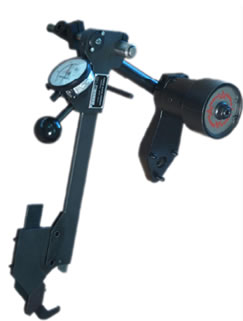Apart from a micrometer, one of the most important measuring instruments an automotive machinist uses when he or she grinds a crankshaft is an Arnold gauge. Unlike any other device, the Arnold gauge allows the operator of a crankshaft grinding machine to precisely read how much material is being taken off of the journal in real time. This ability, to see how much material is being ground off of a journal, allows the operator to grind crankshafts to extremely close tolerances.
 The Arnold gauge, which is pictured left, is not only used in automotive machine shops. Many different industries, such as those involved with manufacturing aerospace and aviation components, rely on an Arnold gauge for a variety of O.D. grinding operations. With an accuracy of .0001”, it is quite easy to see why so many machinists are pleased with how well this gauge performs. Besides being accurate, an Arnold Gauge is also very easy for an operator to use.
The Arnold gauge, which is pictured left, is not only used in automotive machine shops. Many different industries, such as those involved with manufacturing aerospace and aviation components, rely on an Arnold gauge for a variety of O.D. grinding operations. With an accuracy of .0001”, it is quite easy to see why so many machinists are pleased with how well this gauge performs. Besides being accurate, an Arnold Gauge is also very easy for an operator to use.
Being attached to the crankshaft grinding machine, with a spring loaded support arm, allows a crankshaft grinding machine operator to effortlessly attach the gauge on and off of a journal at will. The entire gauge assembly includes a precision dial indicator, durable frame and an adjustable caliper. In most cases, the operator will use a standard caliper that adjusts from 1” to 3” in diameter. This is sufficient for grinding most passenger car and light truck crankshafts. For industrial crankshafts, which tend to have large journals, the caliper can be easily changed to accommodate a journal that is up to 12” in diameter. In the video below, you can view an automotive machinist using his Arnold gauge while grinding a crankshaft.
In the video you will notice just how easy the Arnold gauge can be used. When it is attached to the journal being ground, two round tungsten carbide contact points allow it to ride on the journal and a plunger on top takes the measurements. Although the plunger spring tension can be adjusted, it is not uncommon for these gauges to work well for many years and without the need of factory calibration. However, operator errors can occur that may damage an Arnold gauge.
One of the greatest hazards the Arnold gauge can come into contact with is an oil passage on the crankshaft’s journal. With the gauge riding on three points, including the plunger, any one of these contact points can ride over and into an oil passage. Even the most experienced machinist will have the occasional mishap and catch part of an oil passage, especially when the steady rest is also riding on a very narrow V6 rod journal. Thankfully this gauge is quite durable and can handle minor mishaps. Crankshaft counterweights, on the other hand, can actually catch the side of this gauge and pull it into the journal; thus causing major damage to not only the Arnold gauge, but to the crankshaft being ground and possibly the machine as well. Therefore, an operator must always be alert when using the gauge to measure the material being ground off of a crankshaft.
The Arnold gauge is a standard measuring device used by most within the automotive machining industry to repair crankshafts. These gauges are found on Berco, RMC, Storm Vulcan, Winona Van Norman and many other crankshaft grinding machines throughout the world.
Now that you have learned more about the Arnold gauge, please take this opportunity to help us improve the information on this page by rating it below.
